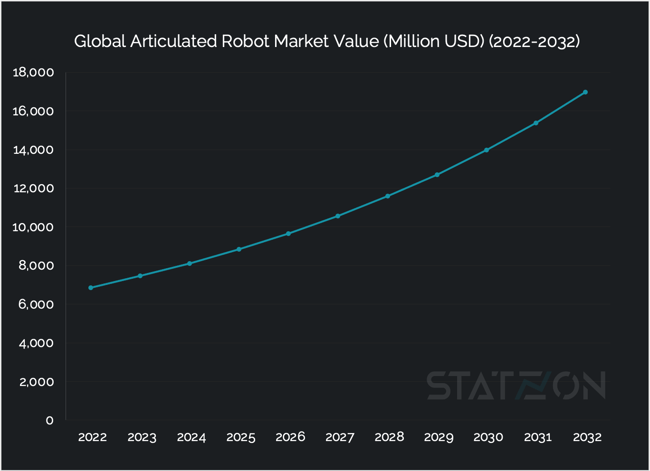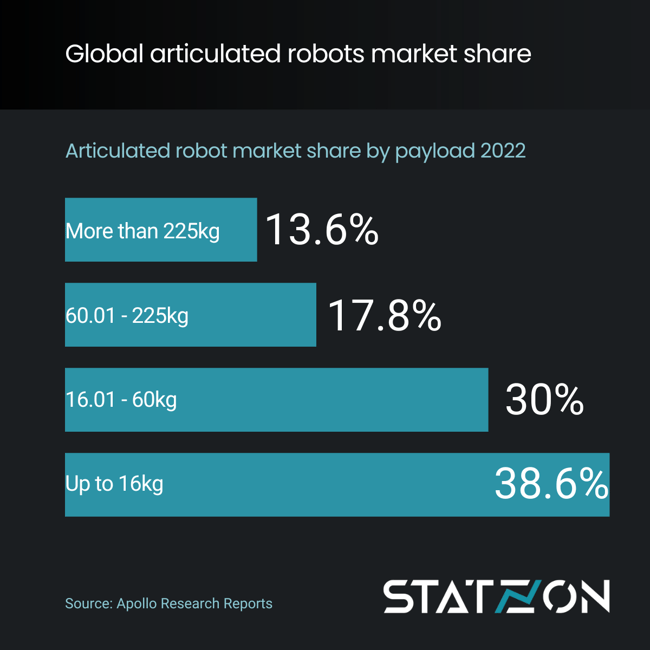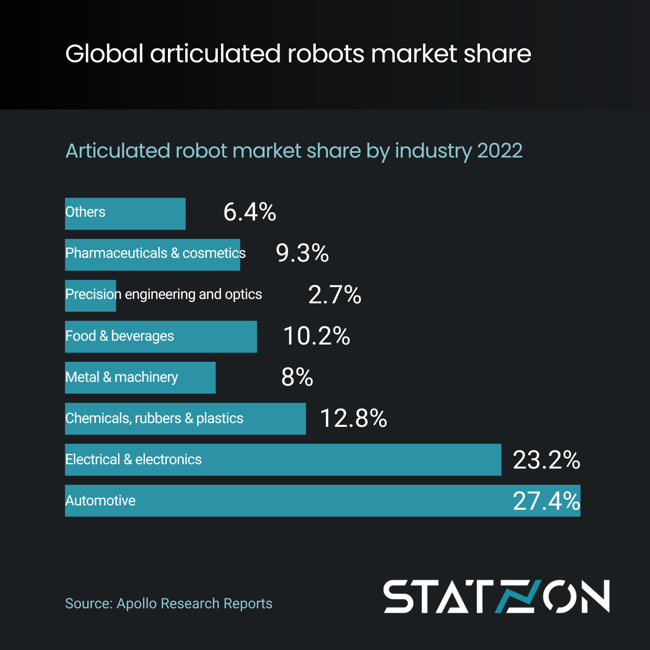In the field of industrial automation, the sight of giant robots skillfully assembling products or carefully painting car bodies is common. Among these, the articulated robot arm stands out as a flexible and increasingly preferred option.
Closely resembling the human arm, the articulated robot tops the list among different types of industrial robots, leading the market with a significant 67% share in 2022, as reported by The Insight Partners. This highlights the clear preference for articulated robots over others. Following behind are cartesian robots with a 19% market share and SCARA robots with a 6% share. Other industrial robot types like collaborative robots and parallel robots account for an even smaller portion of the total market.
Defining Articulated Robots
An articulated industrial robot is characterized by its rotary joints, which allow a full range of motion. With two or more arms and multiple joints, these robots can maneuver in any direction. Their agility and precision make them ideal for various tasks including welding, assembly, painting, and material handling.
Different from other industrial robots like SCARA and cartesian robots, articulated robots boast versatility. Unlike cartesian robots that move linearly along axes or SCARA robots designed for high-speed, plane-restricted tasks, articulated robots can rotate their arms in any direction, addressing tasks that demand a high degree of flexibility.
Articulated Robot Market Size
The global articulated robot market was valued at USD 6.86 billion in 2022 and is projected to skyrocket to USD 16.97 billion by 2032, growing at a CAGR of 9.57% from 2023 to 2032. This data comes from recent market research by Apollo Research Reports.
 Source: Statzon/ Apollo Research Reports
Source: Statzon/ Apollo Research Reports
The trend in articulated robot costs over the past decade shows a promising reduction in prices, making them increasingly accessible for various industries. Analyzing Magna Intelligence’s data on articulated robot prices from 2020 to 2032, there is a consistent decrease in cost year over year. In 2022, the estimated average price of an articulated robot was about USD 61,000. The rate at which the cost drops suggests that this downward trend will likely continue into the foreseeable future.
Projecting this trend to 2032, it's anticipated that the average cost could land around USD 47,000, making it considerably more affordable for industries to integrate these robots into their operations. The reduced cost barrier could significantly contribute to the growing market size, thereby potentially driving further adoption.
Articulated Robot Regional Market Shares
While North America, especially the US, continues to be a significant market for articulated robots, the meteoric rise of the Asia-Pacific region, led by giants like China, signals a shifting epicenter of automation. Europe, with its steady growth led by Germany and the rapid rise of Spain, remains a vital player.
North America: Holding a formidable market value of USD 2.45 billion in 2022, North America is a beacon in the articulated robot sector. The US alone contributes a staggering USD 1.9 billion to this tally. Predictions suggest a CAGR of 8.3% from 2023 to 2032, largely powered by sectors like automotive, aerospace, and electronics. Canada and Mexico, with their growing industrial sectors, are also set to provide a sizable contribution in the forthcoming years.
Europe: Europe's market, valued at USD 2.1 billion in 2022, is significantly influenced by Germany, which boasts a market size of USD 750 million. A projected CAGR of 9.1% until 2032 emphasizes Europe's unwavering commitment to manufacturing excellence. Countries like France, Italy, and the UK, with a combined value of USD 1 billion in 2022, are also key players.
Asia-Pacific: With a market value of USD 2.3 billion in 2022, Asia-Pacific's vibrant industrial landscape is driven primarily by China and Japan. China's market, which was worth USD 1 billion in 2022 with an expected CAGR of 10.5% till 2032, is rapidly advancing its industrial automation capabilities. Japan, not far behind, holds a market value of USD 700 million with a forecasted CAGR of 9.8%. Furthermore, emerging nations like South Korea, India, and Taiwan, which collectively account for USD 500 million in 2022, signal Asia-Pacific's expansive growth trajectory.
Segmenting the Articulated Robot Market
By Payload:
Articulated robot with up to 16 kg payload dominates the market with a value of USD 2.65 billion in 2022. Demand for these robots will remain high through 2032 with the prevalent use in the automotive sector for tasks such as welding and painting. The market for this segment is expected to reach USD 6.05 billion by 2032, growing at a CAGR of 8.69%.
Robots with more than 225 kg, although smaller in market share, will showcase robust growth with a projected CAGR of 11.29% during the forecast period.
By Industry:
The articulated robot market finds its most substantial foothold in the automotive industry, commanding a market share of 27.4% in 2022. This dominance is predicted to continue, with projections showing a surge to USD 4.21 billion by 2032, registering a CAGR of 8.47%. These robots are favored in the car industry due to their adaptability, which simplifies task switches. Their capability to manage large components further boosts their appeal, positioning them as a top robot pick in the automotive sector.
Trailing the automotive sector, the electrical & electronics sector, was appraised at USD 1.6 billion in 2022, with projections indicating a robust escalation to USD 4.2 billion by the end of the forecasted timeline.
Meanwhile, the chemicals, rubber & plastics industry is charting a course to reach USD 2.56 billion by 2032, boasting the highest growth velocity with a CAGR of 11.38%. Particularly, the chemical sector exhibits a notable surge in automation and robot adoption aimed at enhancing precision and mitigating human exposure to hazardous substances or situations.
And then there’s the precision engineering and optics sector that is gearing up for notable ascents, expecting a CAGR of 10.79%, which underscores the versatility and adaptability of articulated robots across a spectrum of industrial realms.
Examining those numbers again, about 50.6% of the articulated robot market was clinched by the automotive and electrical & electronics segments combined. Conversely, while the chemicals, rubbers & plastics, and precision engineering and optics segments held a relatively modest share of around 15.5% in 2022, they are poised to broaden their market stake to 18.1% by 2032.
Sources: Statzon, Apollo Research Reports study on articulated robot market



